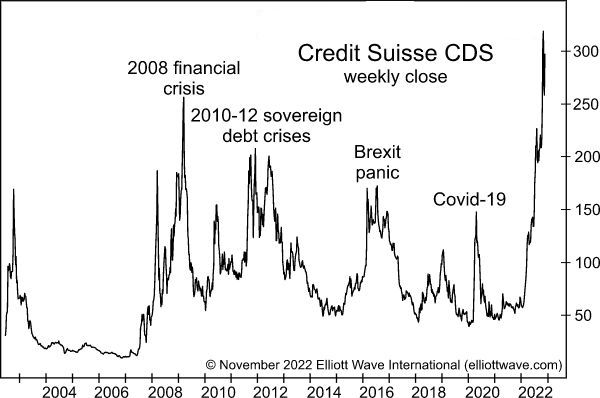Credit Suisse: How the Price of Credit-Default Swaps Provided a Warning
“… exceeded every high-water mark … of the past 15 years”
Credit-default swaps were invented in the mid-1990s but a lot of people did not become aware of them until around 2000, and that awareness increased dramatically during the 2008 financial crisis. As you may recall, so-called CDSs were all over the news then.
Today, these financial derivatives are in the news again.
In a nutshell, credit-default swaps are insurance against a debt default: The higher the perceived risk of default, the higher the premiums.
With that in mind, back in November, the Global Market Perspective, a monthly Elliott Wave International publication which covers 50-plus financial markets, showed this chart and said:

Just last month, Credit Suisse — the once-venerable Zurich-based global investment bank that [the Global Market Perspective] has warned about for years — saw prices for its credit-default swaps (CDS) shoot past 300, indicating investors’ increasing belief that the bank will default. As shown, CDS prices have exceeded every high-water mark set during every crisis of the past 15 years.
Since then, the price of those CDSs have approximately tripled, climbing north of 1000.
As a March 18 news item from The Financial Times noted:
Cost of insuring Credit Suisse debt dwarfs that of other banks
The price of Swiss lender’s credit default swaps climbs to record high this week
During the same weekend that news item published, Credit Suisse collapsed, and the Swiss government brokered a deal which involved rival UBS buying Credit Suisse for $3.2 billion.
Worries about the global banking sector are not confined to Credit Suisse.
Here’s a March 24 headline (CNBC):
Deutsche Bank shares slide after sudden spike in the cost of insuring against its default
Yet, at least one strategist expressed this (Yahoo! Finance, March 24):
Everything ‘really is fine with Deutsche Bank’ due to capital levels, [chief strategist] says
Other professional observers of the banking sector have also basically said “don’t worry, big banks are in good financial health.” But keep in mind that many of these same observers were caught off guard by what’s already occurred with failed banks.
Elliott Wave International has been warning of this persistent optimism. The time will likely soon arrive when even those who are now expressing the most optimism will shift to pessimism.
That will be the juncture of what Elliott Wave International calls the “point of recognition.”
You want to be prepared before then.
Now is the time to read Elliott Wave International’s special report “How Safe Is My Bank?,” which is valued at $49, yet, you can get it for free by following this link.